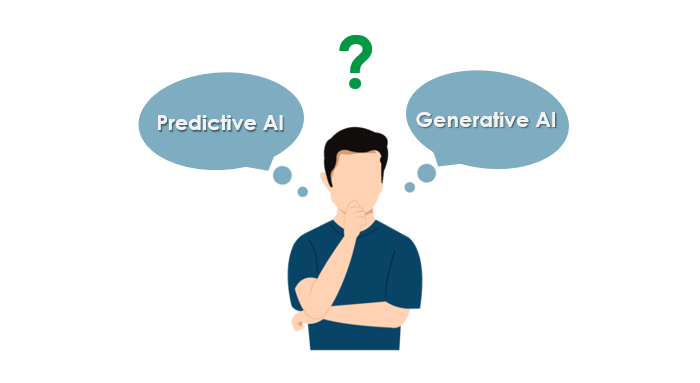
Artificial Intelligence (AI) is transforming industries, enhancing decision-making processes, and creating new opportunities across various domains.
However, selecting the right type of AI for your specific needs can be challenging.
Broadly, AI can be categorized into predictive (sometimes known as discriminative or traditional) AI and generative AI, each serving different purposes. ChatGPT coming online made evident the powerful possibilities of AI and injected into every household, classroom, boardroom conversation.
It kicked up a lot of dust and put pressure on organizations to identify its use. That dust and pressure also clouded the distinct applications for predictive and generative AI. I see this routinely in conversations with our customers and prospects, Afterall, both are trained from and learn from historical data. Understanding the distinctions and appropriate applications of these AI types is crucial for leveraging their full potential.
Looking for heightened out-quarter visibility into a key performance metric? Something that if you knew in advance could lead to clear optimizations and improved outcomes? Predictive!
Looking for an ability to synthesize large volumes of data to create new content or information? An assistant that enables a more insightful and productive interaction with that information? Generativ!

Predictive AI
Predictive AI is designed to predict outcomes based on historical data. About any organizational challenge can be translated into a question onto which a predictive model can be trained, provided there is requisite historical information with which to work. Translate those scenarios into questions where you need to classify data, whether into binary categories, multiple classes, or measure an outcome across a continuous set of values. It learns the boundaries between distinct categories from the data it is trained on and uses this knowledge to make predictions about new, unseen data. More information about defining machine learning questions is available via our documentation site here: Defining machine learning questions | Qlik Cloud Help.
When to Use Predictive AI
Binary Classification:
Example: “Will this customer churn in the next 60 days?”
Caz de utilizare: Customer churn prediction is a classic example of binary classification. Businesses can use predictive AI to identify customers at risk of leaving and take proactive measures to retain them. By analyzing historical data, such as purchase history, engagement levels, and customer support interactions, the AI model can predict the likelihood of churn and help companies devise targeted retention strategies.
Multiclass Classification:
Example: “Which product is this customer more likely to purchase next?”
Use Case: E-commerce platforms can leverage multiclass classification to personalize product recommendations. By examining past purchase behaviors, browsing history, and demographic information, the AI model predicts which products a customer is most likely to buy next. This enhances the shopping experience, increases customer satisfaction, and boosts sales.
Regression/ Numerical Prediction:
Example: “How many days is it likely to take this opportunity to close?”
Use Case: In sales forecasting, discriminative AI can predict the closing time of sales opportunities. By analyzing historical sales data, deal size, customer interactions, and market conditions, the AI model provides an estimated period for deal closure. This helps sales teams prioritize leads, allocate resources efficiently, and improve overall sales performance.
Predictive to Prescriptive AI
Predictive AI models are typically trained using supervised learning techniques, where the model learns from labeled training data. Common algorithms used in predictive AI include logistic regression, decision trees, random forests, support vector machines, and neural networks.
Knowing what is likely to happen using this technique can be exceptionally powerful, providing a forward-looking view into outcomes that matter. However, understanding why those outcomes are likely to occur can be just as powerful, if not more. That is precisely why any predictive application needs to incorporate explainability. Without explainability, there is no clear action to take. Pulling on the churn example, without knowing what is causing the heightened risk of churn, what action does a business take to mitigate the risk?
Incorporating explainability into Predictive AI allows you to move into Prescriptive AI. This affords the opportunity to explore certain actions and measure the impact on the desired outcome. We can model the likely outcomes if we put a customer on a particular support plan, increase engagement, lower price without having to actually taking such actions.
From there, an appropriate, AI-derived action can be mobilized. Extending this from a single action, to a coordinate set of actions allows organizations to develop business optimizations. Set the optimal outcome and allow Predictive AI models to explore the inputs and there many possible iterations to inform a prescriptive set of actions to optimize the probability of that desired outcome.
Suppose a company is facing high churn rates and wants to reduce the number of customers leaving. Using Predictive AI, the company identifies the top factors contributing to churn, such as low engagement and high service costs. With explainability, the company understands why these factors are critical. Moving into Prescriptive AI, the company can simulate different actions, such as offering a personalized support plan, providing additional engagement opportunities through targeted marketing campaigns, and offering discounts to at-risk customers. By running these simulations, the AI model suggests a combination of these actions that are most likely to reduce churn. The company can then implement this coordinated strategy, continuously monitor the results, and make adjustments as needed based on ongoing predictions and feedback. This integrated approach not only helps in retaining customers but also enhances their overall satisfaction and loyalty.

Generative AI
Generative AI, on the other hand, is focused on creating new content. It can generate text, images, music, and more, making it a powerful tool for content creation and natural language processing. Generative AI models learn the underlying patterns and structures of the data they are trained on and use this knowledge to produce original outputs.
When to Use Generative AI
Question-and-Answering Systems:
Example: Building intelligent chatbots or virtual assistants that can answer customer queries in real-time.
Use Case: Customer support can be significantly enhanced with Generative AI. Instead of relying solely on pre-defined responses, generative AI models can understand and respond to customer queries contextually. This leads to more accurate and satisfactory customer interactions, reducing the load on human support agents.
Document Summarization:
Example: Automatically summarizing lengthy reports, articles, or research papers.
Use Case: Generative AI can streamline the process of digesting large volumes of information by providing concise summaries. This is particularly useful in fields like law, medicine, and academia, where professionals need to stay updated with extensive literature.
Context-Specific Knowledge Bases:
Example: Creating a dynamic knowledge base that adapts to new information and provides relevant insights.
Use Case: In industries like finance and healthcare, Generative AI can maintain and update knowledge bases that evolve with new data. This ensures that professionals have access to the most current and relevant information, aiding in decision-making processes.
Personalized Communication:
Example: “This customer is 70% likely to churn because of reasons X, Y, Z. Write an email proposing changes to address concerns.”
Use Case: Generative AI can craft personalized emails or messages based on specific customer data and predicted behaviors. By tailoring communication to address individual concerns, businesses can improve customer engagement and retention.
Generative AI models are often built using techniques such as Generative Adversarial Networks (GANs), Variational Autoencoders (VAEs), and Transformer-based models like GPT (Generative Pre-trained Transformer). These models are trained on large datasets to learn the intricate details required to generate new, coherent, and contextually appropriate content.
Like Predictive AI, Generative AI is enhanced substantially by explainability. Knowing how a Generative AI solution derived its answer, content, etc. Is vitally important to trusting its use. This is the academic equivalent of “showing your work” and providing proper citations and derivations from others’ work and leads to higher-quality, higher-conviction Generative AI applications.

Bridging the Gap: Combining Predictive and Generative AI
While Predictive and Generative AI serve distinct purposes, combining them can lead to more robust and comprehensive solutions. For instance, a predictive model can identify potential customer churn, while a generative model can craft personalized communication to address and mitigate the risk. This synergy enhances the overall effectiveness of AI applications, providing both accurate predictions and innovative content creation.
Example: Customer Retention Strategy
Step 1: Prediction:
Use Predictive AI to analyze customer data and predict churn probabilities.
Identify customers with high churn risk.
Capture the model inputs that are causing the heightened risk via the explainability metrics.
Step 2: Personalization:
Use Generative AI to create personalized emails or messages for at-risk customers.
Feed Generative AI the inputs causing heightened risk in order to address specific concerns and propose tailored solutions.
Step 3: Execution and Monitoring:
Send the personalized communications and monitor customer responses.
Adjust strategies based on feedback and ongoing predictions.
This integrated approach not only improves retention rates but also enhances customer satisfaction and loyalty.

Choosing the right type of AI—predictive or generative—depends on your specific needs and goals. Predictive AI is ideal for making accurate predictions based on historical data, while Generative AI excels in creating new, context-specific content. By understanding the strengths and applications of each, businesses can harness the full potential of AI to drive innovation, improve decision-making, and deliver exceptional experiences.
For both predictive and generative AI, there is so much untapped potential—and the journey should start with your data. As enterprises become more accustomed to AI, new opportunities and use cases will emerge. Utilizing AI at an enterprise level will drive innovation and uncover applications previously unconsidered, expanding the technology’s impact.
You can leverage the power of Predictive AI and Generative AI today with Qlik™ not only with its augmented analytics capabilities but also with Qlik AutoML® allowing analytics users to easily generate predictive analytics. You can also leverage advanced AI Integration by taking advantage of 3rd party data science and Generative AI models with Qlik™.
The Qlik™, Qlik™ Talend Cloud and Qlik Answers®, are pivotal. Qlik™ Talend Cloud enhances data integration with AI-driven processes, while Qlik Answers® transforms unstructured data into actionable insights, ensuring businesses leverage their data effectively and comprehensively. Find out more AI & Machine Learning Capabilities | Qlik Data Driven Insights.
Article source: qlik.blog.
For information about Data Products capabilities Qlik™ Talend Cloud, click here: https://qqinfo.ro/en/data-products-capabilities-in-qlik-talend-cloud/.
For information about Qlik Answers®, click here: https://qqinfo.ro/en/qlik-answers-en/.
For information about Qlik™, click here: qlik.com.
For specific and specialized solutions from QQinfo, click here: QQsolutions.
In order to be in touch with the latest news in the field, unique solutions explained, but also with our personal perspectives regarding the world of management, data and analytics, click here: QQblog !